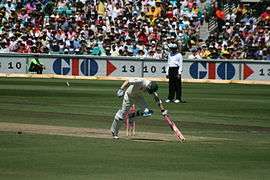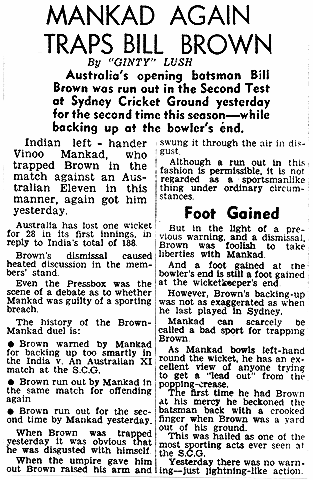Run out
Run out is a method of dismissal in the sport of cricket governed by Law 38 of the Laws of cricket.[1]

Laws
A batsman is out Run out if at any time while the ball is in play no part of his bat or person is grounded behind the popping crease and his wicket is fairly put down by the opposing side.
A batsman may be dismissed Run out whether or not a run is being attempted, even if the delivery is a no-ball (i.e. not a fair delivery). There are a number of exceptions to this:
- A batsman is not run out if he or his bat had been grounded behind the popping crease, but he subsequently leaves it to avoid injury, when the wicket is put down.
- A batsman is not run out if the ball has not been touched by a fielder, after the bowler has delivered the ball, before the wicket is put down. (This means that the non-striker is not out if a ball hit by the striker puts down the non-striker's wicket, provided the ball did not touch any member of the fielding side before doing so.)
- A batsman is not given out Run out if he can be given out Stumped.
The batsman can be judged run out when he is closest to the end where the wicket has been put down by the opposition. The runs completed before a Run out are still scored by the batsman and his team. The bowler does not get credit for the wicket.
Frequency
In Tests, Run out is the fourth most common dismissal method, behind caught, bowled and lbw, accounting for 1 in 29 dismissals. In One Day Internationals and T20Is, when more risks are taken with running (and fewer defensive shots played), it is the third most common, moving ahead of lbw and accounting for 1 in 8 dismissals.
Run out with runners
If a batsman has a runner due to injury/illness there is the danger of being run out due to confusion between the three (or four in very rare circumstances) batsmens/runners on the field, all of whom must be safe in their crease when the wicket is broken and also at the correct end of the wicket. For example, a batsman who is batting with a runner should always be behind the crease at the striker's end whilst the ball is live. If he forgets that he has a runner a quick minded fielder is able to break the stumps at the striker's end to run him out – even if he finds himself safely behind the crease at the bowler's end.
Running out a batsman "backing up" (Mankad)
As a bowler enters his delivery stride, the non-striking batsman usually 'backs up'. This means he leaves his popping crease and walks towards the other end of the wicket so that it will take him less time to reach the other end if he and his batting partner choose to attempt a run.
Sometimes a batsman, whilst backing up, leaves the popping crease before the bowler has actually delivered the ball. Where this has happened, the bowler may attempt to run the non-striking batsman out in accordance with the Laws of the game. If he fails, and the batsman has remained within the crease, the delivery is called a dead ball.
Some observers feel that dismissing a batsman in this way is against the spirit of the game, but others believe that the Laws and regulations exist to be used and that, as the run out backing up is expressly within the professional regulations, it is legitimate and sporting to exercise the provision.[2]
According to the former convention, a generous bowler may warn a batsman to stay in his crease rather than to take his wicket, but this is not required by the Laws of the game nor the MCC guidance notes on the Spirit of Cricket. When the run out has happened in first-class cricket, it has on occasion provoked debate.[3] Such dismissals have always occurred and continue to divide opinion.[4][5]
Vinoo Mankad
The most famous example of this method of dismissal involved the Indian bowler Vinoo Mankad. It occurred during India's tour of Australia on 13 December 1947 in the second Test at Sydney. Mankad ran out Bill Brown when, in the act of delivering the ball, he held on to it and removed the bails with Brown well out of his crease. This was the second time Mankad had dismissed Brown in this fashion on the tour, having already done it in an earlier match against an Australian XI.[6] On that occasion he had warned Brown once before running him out. The Australian press accused Mankad of being unsportsmanlike, although some Australians, including Don Bradman, the Australian captain at the time, defended Mankad's actions. Since this incident, a batsman dismissed in this fashion is (informally) said to have been "Mankaded".

Modern interpretations of run out of non-striker
In all matches played under the Laws of cricket with no augmented playing conditions, the bowler may, after he has started his run up, but before he would normally have been expected to release the ball, attempt to run out a non-striker who has strayed outside his crease, with no warning mentioned. If the fielding side appeal the umpire will give the batsman out run out Under Law 41.16.[7] The previous Laws were more restrictive as to when a bowler could attempt this, but they still allowed an attempt up until a bowler entered his delivery stride, which differed from the international game.
The 2011 ICC Playing Conditions for Test matches,[8] One Day Internationals[9] and Twenty20 Internationals[10] had relaxed the rules on Mankading making it more likely in the International game and other forms of professional cricket including the Indian Premier League (IPL).[11]
According to the various professional playing conditions, 42.11, "The bowler is permitted, before releasing the ball and provided he has not completed his usual delivery swing, to attempt to run out the non-striker." The umpires shall deem the bowler to have completed his delivery swing once his bowling arm passes the normal point of ball release.[12]
In July 2014, England's Jos Buttler was run out by Sri Lanka's Sachithra Senanayake. The World Cricket Council, an independent consultative body of former international captains and umpires, unanimously expressed support of Sri Lanka's actions and a lack of sympathy with the batsman.[13] In March 2019, Buttler was dismissed in the same way by Ravichandran Ashwin in the 2019 Indian Premier League.[14][15] Following the incident, the MCC said that this particular 'Mankading' was not in the "spirit of the game".[16]
The Spirit of Cricket, which is a preamble to the Laws, lists a series of behaviours considered by the cricket community to be unsporting or contrary to the Spirit of the Game, but dismissing the non-striker whilst backing up is not mentioned.
References
- "Law 38 – Run out". MCC. Retrieved 29 September 2017.
- Cameron Tomarchio (3 February 2016). "What Don Bradman said about Mankading". news.com.au. Retrieved 3 February 2016.
- Steve Harmison (4 June 2014). "BBC Sport – Jos Buttler run-out defended by Sri Lanka captain Angelo Mathews". Bbc.co.uk. Retrieved 18 August 2014.
- "Mankading incident turns close finish controversial". ESPN Cricinfo. Retrieved 18 October 2017.
- "Mankad sparks contentious finish". Cricket Australia. Retrieved 19 October 2017.
- "Two legends make their entrance". ESPN Cricinfo. Retrieved 19 November 2019.
- "Law 41". MCC. Retrieved 29 September 2017.
- "STANDARD TEST mATCH PLAYING CONDITIONS" (PDF). International Cricket Council.
- "STANDARD ONE-DAY INTERNATIONAL mATCH PLAYING CONDITIONS" (PDF). International Cricket Council. Archived from the original (PDF) on 4 March 2016.
- "STANDARD TWENTY20 INTERNATIONAL mATCH PLAYING CONDITIONS" (PDF). International Cricket Council.
- "IPLT20 match playing conditions 42 Law 42 Fair and Unfair Play". BCCI. Archived from the original on 25 April 2013.
- "ICC news: Powerplay tweaks and end of runners | Cricket News | Cricinfo ICC Site". ESPN Cricinfo. Retrieved 18 August 2014.
- "World Cricket Committee Running out the non-striker: Law is clear and the act is not against the Spirit of Cricket; Lord's". Lords.org. Retrieved 18 August 2014.
- "Buttler's controversial 'Mankad' run out – best of the reaction". International Cricket Council. Retrieved 25 March 2019.
- "Jos Buttler 'Mankad' dismissal: Law is 'essential' says MCC". 26 March 2019 – via www.bbc.co.uk.
- "Jos Buttler: 'Mankad' dismissal not 'in the spirit of the game' - MCC". 27 March 2019. Retrieved 28 March 2019 – via www.bbc.co.uk.